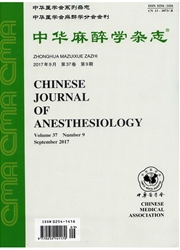

 中文摘要:
中文摘要:
目的评价肠缺血再灌注对大鼠脑的影响。方法健康雄性成年SD大鼠64只,采用随机数字表法,将其随机分为2组(n=32):假手术组(S组)和肠缺血再灌注组(II/R组),采用Morris水迷宫实验测定认知功能,随后II/R组采用夹闭肠系膜上动脉90min后再灌注的方法制备肠缺血再灌注模型,S组仅分离肠系膜上动脉,不夹闭。于再灌注2、6、12、24h时各组随机取8只大鼠,经心脏取血2ml后,取肠及脑组织,光镜下观察病理学结果,采用改良Chiu评分法评价肠粘膜损伤程度,采用ELISA法测定血浆TNF—α和IL-6浓度,采用TUNEL法检测皮层脑组织细胞凋亡情况;于再灌注24h时采用Morris水迷宫实验测试认知功能。结果S组大鼠肠及脑组织镜下结构未见异常,II/R组再灌注6h后可见明显肠道和脑损伤。与S组比较,II/R组再灌注2、6、12和24h时Chiu评分、血浆TNF-α及IL-6浓度升高,再灌注6、12和24h时细胞凋亡数增加,再灌注24h时大鼠潜伏期、游泳距离增加,穿越平台次数减少(P〈0.05或0.01),游泳速度差异无统计学意义(P〉0.05)。结论肠缺血再灌注损伤可诱发大鼠脑损伤,引起认知功能减退,可能与炎性介质的释放及神经细胞凋亡有关。
 英文摘要:
英文摘要:
Objective To investigate the effects of intestinal ischemia-reperfusion (I/R) on the brain in rats. Methods Sixty-four healthy male SD rats weighing 250-300 g were randomly allocated to one of 2 groups ( n = 32 each) : sham operation group (S) and intestinal I/R group (I/R). Intestinal I/R was produced by occlusion of superior mesenteric artery (SMA) for 90 min followed by reperfusion. Eight animals were sacrificed at each of the following time points: 2, 6, 12 and 24 h of reperfusion (T1-4) in each group. After a median sternotomy blood samples were taken from left ventricle for measurement of plasma TNF-α and IL-6 (by ELISA) . Intestine and brain tissue was harvested for microscopic examination and detection of apoptosis (by TUNEL). The cognitive function was tested using Morris water maze at 24 h. Results No abnormality was found in intestine and brain tissue in group S. Intestinal damage and neurodegeneration were detected in group I/R. Intestinal I/R signifcantly increased cerebral apoptosis in group I/R compared with group S. Plasma TNF-u and IL-6 concentrations were significantly higher at T, 4 in group I/R than in group S. The escape latency and swimming distance were significantly increased, while the number of crossing the platform was decreased in group I/R compared with group S. There was no significant difference in the swimming speed between the 2 groups. Conclusion Intestinal I/R can induce brain injury and lead to cognitive dysfunction. I/R-induced release of inflammatory mediators and neuronal apoptosis are involved in the underlying mechanism.
 同期刊论文项目
同期刊论文项目
 同项目期刊论文
同项目期刊论文
 期刊信息
期刊信息
